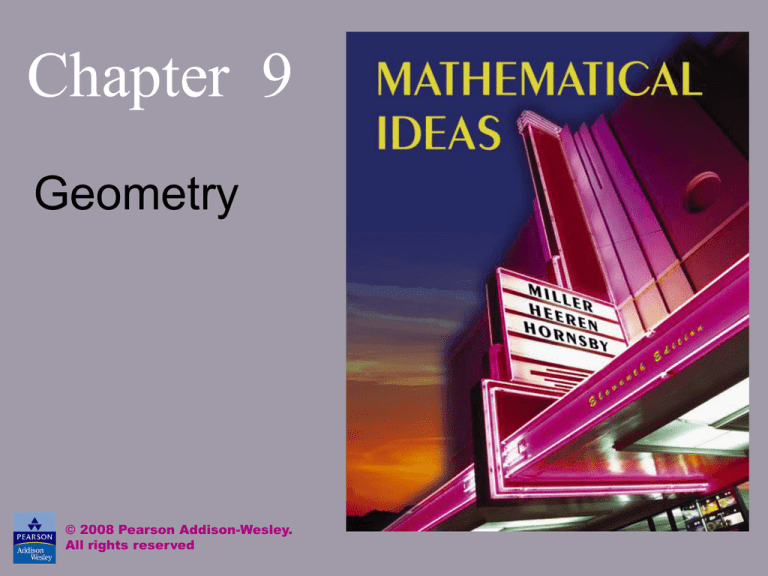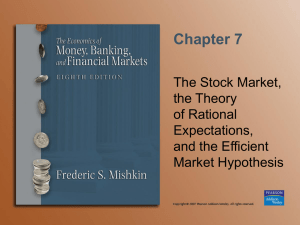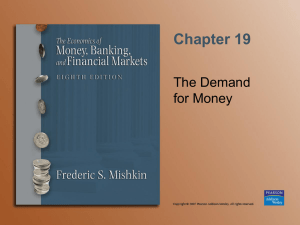
Chapter 9
Geometry
© 2008 Pearson Addison-Wesley.
All rights reserved
Chapter 9: Geometry
9.1
9.2
9.3
9.4
9.5
9.6
9.7
9.8
Points, Lines, Planes, and Angles
Curves, Polygons, and Circles
Perimeter, Area, and Circumference
The Geometry of Triangles: Congruence,
Similarity, and the Pythagorean Theorem
Space Figures, Volume, and Surface Area
Transformational Geometry
Non-Euclidean Geometry, Topology, and Networks
Chaos and Fractal Geometry
9-6-2
© 2008 Pearson Addison-Wesley. All rights reserved
Chapter 1
Section 9-6
Transformational Geometry
9-6-3
© 2008 Pearson Addison-Wesley. All rights reserved
Transformational Geometry
• Reflections
• Translations and Rotations
• Size Transformations
9-6-4
© 2008 Pearson Addison-Wesley. All rights reserved
Transformational Geometry
One branch of geometry, known as
transformational geometry, investigates
how one geometric figure can be transformed
into another. In transformational geometry
we are required to reflect, rotate, and change
the size of the figures.
9-6-5
© 2008 Pearson Addison-Wesley. All rights reserved
Reflections
Line m is perpendicular to the line segment AA’ and also
bisects it. We call A’ the reflection image of the point A
about the line m. Line m is called the line of reflection
for points A and A’. The dashed line shows that the
points are images of each other under this
transformation.
A
m
A’
9-6-6
© 2008 Pearson Addison-Wesley. All rights reserved
Reflection
The set of all reflection images of points of the
original figure is called the reflection image of the
figure.
We call reflection about a line the reflection
transformation.
If a point A and its image, A’, under a certain
transformation are the same point, then A is an
invariant point of the transformation.
9-6-7
© 2008 Pearson Addison-Wesley. All rights reserved
Example: Reflection Image About Line m
m
m
m
9-6-8
© 2008 Pearson Addison-Wesley. All rights reserved
Reflection
Three points that lie on the same line are called
collinear. The reflection image of a line is also a
line. Thus we say that reflection preserves
collinearity.
9-6-9
© 2008 Pearson Addison-Wesley. All rights reserved
Line of Symmetry
The figure below is its own reflection image about the
lines of reflection shown. In this case, the line of
reflection is called a line of symmetry.
9-6-10
© 2008 Pearson Addison-Wesley. All rights reserved
Composition
We will use rm to represent a reflection about
a line m, and let us use rn rm to represent a
reflection about line m followed by a
reflection about line n. We call rn rm the
composition, or product, of the two
reflections.
9-6-11
© 2008 Pearson Addison-Wesley. All rights reserved
Translation
The composition of two reflections about parallel
lines is a translation.
m
n
9-6-12
© 2008 Pearson Addison-Wesley. All rights reserved
Translations
The distance between a point and its image under a
translation is called the magnitude of the translation.
A translation of magnitude 0 leaves every point of the
plane unchanged and is called the identity
translation. A translation of magnitude k, followed
by a similar translation of magnitude k but of the
opposite direction returns a point to its original
position and these translations are called inverses of
each other.
9-6-13
© 2008 Pearson Addison-Wesley. All rights reserved
Rotations
The composition of two reflections about nonparallel
lines is called a rotation. The point of intersection of
these lines is called the center of rotation.
m
n
B
9-6-14
© 2008 Pearson Addison-Wesley. All rights reserved
Example: Rotation
Find the image of a point P under a rotation
transformation having center at a point Q and
magnitude 90° clockwise.
Solution
P
Q
90°
P’
9-6-15
© 2008 Pearson Addison-Wesley. All rights reserved
Point Reflection
A rotation transformation having center Q
and magnitude 180° clockwise is sometimes
called a point reflection.
9-6-16
© 2008 Pearson Addison-Wesley. All rights reserved
Example: Point Reflection
Find the point reflection image of the figure about
point Q.
Solution
Q
9-6-17
© 2008 Pearson Addison-Wesley. All rights reserved
Glide Reflection
Let rm be a reflection about line m, and let T be a
translation having nonzero magnitude and a direction
parallel to m. The composition of T followed by rm
is called a glide translation.
m
9-6-18
© 2008 Pearson Addison-Wesley. All rights reserved
Isometries
Isometries are transformations in which the
image of a figure has the same size and
shape as the original figure.
9-6-19
© 2008 Pearson Addison-Wesley. All rights reserved
Size Transformation
A size transformation can have any positive real
number k as magnitude. A size transformation
having magnitude k > 1 is called a dilatation, or
stretch; while a size transformation having
magnitude k < 1 is called a contraction, or shrink.
9-6-20
© 2008 Pearson Addison-Wesley. All rights reserved
Example: Size Transformation
Apply a size transformation with center M
and magnitude 1/3 to the triangle below.
Solution
M
9-6-21
© 2008 Pearson Addison-Wesley. All rights reserved
Example: Size Transformation
Apply a size transformation with center M
and magnitude 1/3 to the triangle below.
Solution
M
9-6-22
© 2008 Pearson Addison-Wesley. All rights reserved
Summary of Transformations
Composition of n
reflections?
n=1
Translation
Yes
Yes
Magnitude 0
Same magnitude;
opposite direction
n = 2, parallel
Isometry?
Invariant points?
Yes
Line of reflection
Yes
None
Preserve collinearity ?
Preserve distance?
Identity?
Inverse?
Reflection
Yes
Yes
None
None
9-6-23
© 2008 Pearson Addison-Wesley. All rights reserved
Summary of Transformations
Rotation
Preserve collinearity ?
Yes
Preserve distance?
Yes
Identity?
Magnitude 360°
Inverse?
Same center;
magnitude (360 – x)°
Composition of n
n = 2, nonparallel
reflections?
Isometry?
Yes
Invariant points?
Center of Rotation
Glide Reflection
Yes
Yes
None
None
n=3
Yes
None
9-6-24
© 2008 Pearson Addison-Wesley. All rights reserved
Summary of Transformations
Preserve collinearity ?
Preserve distance?
Identity?
Inverse?
Composition of n
reflections?
Isometry?
Invariant points?
Size Transformation
Yes
No
Magnitude 1
Same center; magnitude
1/k
No
No
Center of transformation
9-6-25
© 2008 Pearson Addison-Wesley. All rights reserved








